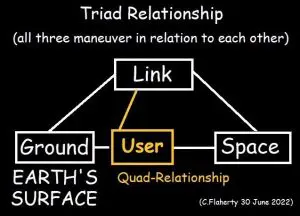
Written by Chris Flaherty.
Ukraine and Taiwan share similar status as potential User, and Mid-Level Space Powers.
This paper looks at the question how these two countries attain Space Power through Third Party Private Providers – who own and operate Space Infrastructure orbiting in the ESL: Earth’s Satellite Layer. In the case of the Space Superpowers (like the United States or China) these have constellations of Military-use Satellites, which are expected to evolve rapidly: “In the Space Domain … [reducing]… adversary incentives for early attack by fielding diverse, resilient, and redundant satellite constellations.” (United States, 2022).
In addition, to the Military-use Satellite Constellations, there are also Third Party Private Provider’s Remote Sensing Satellites operating in the ESL: Earth’s Satellite Layer. The Third Party Private Providers operate commercial satellites that potentially give key Space-based capabilities, creating the equivalent of Space Power traditionally enjoyed by the United States, since the First Space War, the 1991 Persian Gulf War (Greenemeier, 2016).
Third Party Private Providers operate commercial-grade Remote Sensing Satellites, and can offer complementary services to countries, who do not have access to their own Military-use Satellite Constellations.
Private Space-based services provide satellites that can conduct ISR: Intelligence, Surveillance and Reconnaissance activities, through access to the following categories of orbiting Spacecraft:
OPTICAL | Optical Imaging Satellite (visible light pictures). |
SAR | Synthetic Aperture Radar Satellite (can see through smoke, clouds and at night). |
ELINT | Electronic Intelligence Satellites (monitoring Radio Frequency Signals). |
The strategic-military revolution of the last few years has been an emerging threat from a proliferation of high-resolution private owned and operated Space-based ubiquitous Remote Sensing Satellites (Townsend, 2021).
Historically, “Space ISR capabilities have been prohibitively expensive for most … countries.
This has changed. Now, many smaller countries can purchase commercially available Space-based optical, SAR, and emerging ELINT capabilities, or even acquire their own satellite or multi-satellite constellation at an affordable cost.” (Wang, 2021).
The key issue is that commercial SAR: Synthetic Aperture Radar imagery has become available at the resolutions necessary to achieve land surveillance and maritime domain awareness (Townsend, 2021; Wang, 2021).
The implications are that: “we’re in the midst of the first real Space war in which corporate players are exerting major influence over the action on the ground.” (Vance, 2022) Operating as military-level commercial systems (Wang, 2021), OPTICAL: Satellite Optical Imaging; SAR: Synthetic Aperture Radar; and ELINT: Electronic Intelligence satellites play a fundamental role in Left-of-Launch Forewarning, Launch, and Right-of-Launch Periods.
SPACE LEFT-OF-LAUNCH FOREWARNING, LAUNCH, AND RIGHT-OF-LAUNCH PERIODS
Space-based sensing from the ESL: Earth’s Satellite Layer, falls into three time-periods:
SPACE LEFT-OF-LAUNCH FOREWARNING PERIOD: |
This covers the ‘before conflict period’ where Intelligence assets – such as Military-use Satellite Constellations, or Third Party Private Provider’s Spacecraft forewarn by monitoring and assessing potential threats: “[data is collected]… from the operational environment, then process and exploit the data to generate information that is analyzed to produce the intelligence upon which military and political decisions are made.” (Wang, 2021) In this period, ISR: Intelligence, Surveillance and Reconnaissance satellites, and other types (military and private versions) can overfly portions of the Earth’s surface, and without restriction (such as being subject to Shutter-Control: stopping a picture of the Earth’s surface from being taken) recording potentially warlike activities, and associated patterns of behaviour like forces being massed – that are visible from Space. |
LAUNCH PERIOD: |
First-Strike Missile Attacks Open Hostilities. |
SPACE RIGHT-OF-LAUNCH PERIOD: |
In this period, ISR: Intelligence, Surveillance and Reconnaissance satellites, and other types (military and private versions) can support deployment of defensive forces, provide missile launch detection, enemy positions and movement knowledge, damage assessment, while supporting governmental, civil and defensive forces with internet access, telecommunications, navigation, and weather services. |
In general, Third Party Private Provider’s SAR: Synthetic Aperture Radar satellite-based capabilities are essential in both the Left-of-Launch Forewarning, Launch and Right-of-Launch Periods (Wang, 2021).
SAR provides ISR: Intelligence, Surveillance and Reconnaissance capabilities, can operate at night and through clouds when optical imaging is blinded, imaging ships, missile launches, or other assets, “when all radio frequency emissions are turned off to avoid detection.” (Wang, 2021).
UKRAINE CASE STUDY
Ukrainian Space Power attainment has occurred in the Space Right-of-Launch Period accessing Third Party Private Provider’s Remote Sensing Satellites, in the context of Russia’s major invasion that took place in 2022.
It is known Ukraine, and much of the global news services, over late 2021, and into 2022 have been provided with thousands of images from satellites owned by companies such as Maxar Technologies, and Planet Labs PBC (Vance, 2022).
Planet Labs is an American public Earth imaging company based in San Francisco, who’s goal, “is to image the entirety of the Earth daily to monitor changes and pinpoint trends.” (Planet Labs).
Photographs from Space, provided by Maxar Technologies, and Planet Labs perform much of the Space-based ISR: Intelligence, Surveillance and Reconnaissance activities, and it is known that, “Ukrainian Space mogul Max Polyakov helped form a coalition of commercial Space companies to gather and analyze satellite images and data. The results were fed to the Ukrainian military, giving it a flood of intelligence information.” (Vance, 2022).
More recently Ukrainian Space Power was expanded, gaining exclusive access purchase of ICEYE SAR: Synthetic Aperture Radar satellites network capable of imaging locations at night, through clouds, fog and smoke, giving situational dominance over the battlefields of Ukraine, as it has been reported recently:
“The ICEYE satellite, purchased with money raised by Ukrainians, detected more than 60 units of enemy military equipment during its first two days of operation. Russian troops lost armored vehicles worth more than the cost of the entire satellite project.” (Kyiv Post, 2022).
In addition to ISR: Intelligence, Surveillance and Reconnaissance activities from Space gained through Third Party Private Providers, Starlink User accessibility became a key pillar of Ukrainian Space Power in the communications realm. Russia’s invasion of Ukraine sought to destroy communications systems.
However, Ukrainian forces have been able to maintain internet and communications using, Starlink network satellites, which beam down high-speed internet service to their antennas on Earth, which are easy to carry around and set-up, and these have been used in large numbers.
The system replaces the need for Earth surface-based fiber-optic services and cell towers housing electronic communications equipment, and antenna to support internet and communication networks (that were systematically destroyed by the Russians).
Starlink access has also allowed Ukrainian ground forces to facilitate drone flights, precision missile and artillery strikes.
This level of functionality has occurred even though, Musk in October was asked about Starlink access issues, stating: “Starlink is not meant for use in offensive military action.” (Vance, 2022).
The end goal currently for Ukrainian Space Power is achieving the three pillars of the Ukrainian Space Programme (Usov, 2022), by securing:
(1) | Remote Sensing Services | Replicating Military ISR: Intelligence, Surveillance and Reconnaissance activities from Space, gained through Private Providers. |
(2) | Communications Services | Starlink User access has achieved wide-area communications accessibility over the battlefield by multiple mobile forces; even though that accessibility is dependent on a Private Company to provide Space access using its force of satellites. |
(3) | Autonomous capacity to bring this infrastructure into orbit. | |
The final pillar of Ukrainian Space Power is possessing the autonomous capacity to bring its Remote Sensing and Communications Services infrastructure into orbit.
Sovereign launch capacity using fixed, or mobile: Space-based, Air lifted or sea platforms can change the status of a User – Space Power: an entity dependent on a Third Party to give access to Space, to that of a Mid-Level Space Power, who can operate in both Left (Forewarning), Launch and Right-of-Launch Periods.
TAIWAN CASE STUDY
In the Ukrainian case study, “when communication towers are brought down on the ground in Ukraine, they’re backstopped by data beamed from above.” (Vance, 2022). Recent Nord Stream pipelines sabotage, apparently an undersea attack, has raised concern over viability of other Undersea Critical Infrastructure such as submerged internet cables, and the ability to transfer into Space the same functions using as a back-up the ESL: Earth’s Satellite Layer.
An early Space Industrialization concept was the notion of, “Complexity Inversion” (Gould, 1978). Complexity Inversion is where initially the bulk of a system at its Space-End is small and light. The corresponding Ground Segments are massive and complex. Advances in technology, and keeping within reasonable launch cost limitations, the reverse of this situation becomes feasible to make the Space Segment vastly more capable and complex.
Complexity Inversion was originally conceived in relation to creating a Space-based Information Infrastructure. The same approach has been considered in relation to Taiwan critical dependence on its submerged internet cables – ‘In times of cyber security attacks … it has been pointed-out that submarine cables is one of the vulnerabilities … these are places that connect us to the world … so learning from Ukraine we are now investing … to build … [hundreds of]… mobile or fixed satellite receivers for the known Geostationary satellites in orbit so we can still keep a line open to talk to our … Allies … around the world … even in the event of the secret destruction of our submarine cables.’ (Tang, 2022; Flaherty Transcription).
The Taiwanese Governmental proposed satellite trial program is to try to guarantee internet services across the country. Based on talks with Private Sector Companies and the Government. Collaboration is with vendors in Mid-Earth Orbit, and will expand to new vendors in Low-Earth Orbit. Taken together this provides a heterogeneous – composed of various vendor, solutions to ensure real time access in times of crisis (Tang, 2022; Flaherty Transcription).
One of the key limitations of the User – Space Power is its high-level of dependency on Third Party Private Providers and commercial considerations. It was widely reported as Ukrainian forces began to advance deeper into Russian occupied regions, in October Starlink access became an issue, as it was reputed to have been turned-off (Vance, 2022). A subsequent payment dispute saw SpaceX request the United States and its allies foot much more of the bill for Starlink in Ukraine, only to be later reversed (Vance, 2022). Musk has pledged to keep funding operations, including purchase of antennas and telecommunications services needed to run them (Vance, 2022).
The Taiwanese concept of Space Power attainment is focused on the full-spectrum Left-of-Launch Forewarning, Launch and Right-of-Launch Periods. It is seen as critical to secure control of SAR: Synthetic Aperture Radar satellites access; the need being so great that, “direct ownership, and thus, imaging prioritization, is essential … [and]… purchasing SAR satellite images now presents a critical new ISR source for Left-of-Launch Forewarning.” (Wang, 2021).
The same logic applies to ELINT: Electronic Intelligence satellites access for Taiwan (Wang, 2021).
In the case of Taiwan a hybrid program is likely to emerge. However, it is acknowledged, “the learning curve for homegrown satellite SAR and programs is incredibly steep. The hardware, software, and analytical processes are challenging to build and integrate. Notwithstanding, launch bookings run years into the future.” (Wang, 2021).
The approach may be leveraging newly available commercial SAR: Synthetic Aperture Radar satellites access services, and simultaneously investing in a domestically owned constellation (Wang, 2021). A national SAR system can then be augmented by commercial services for use in the Left-of-Launch Forewarning Period, and as a key source of data acquisition for future defence planning. In the Right-of-Launch Period the national SAR constellation is essential for surveillance, targeting information, and damage assessments through smoke, fog and the night-time period (Wang, 2021).
THE USER – SPACE POWER
Space Power is a product of Complexity Inversion, where the complex part of a system (and its bulk), is transferred from the Terrestrial Surface to Space. Looking at Ukrainian and Taiwanese routes to Space Power attainment, these operate as User, or Mid-Level Space Powers. As a starting point, in this discussion, both Ukraine and Taiwan operate at the level of User – Space Powers, this is based on the Quad-Relationship, containing four Segments:
(1) Ground Segment. (2) Link Segment. (3) User Segment. (4) Space Segment. This arrangement is found in the Australian Space Power EManual (Australian Government, 2021). The User – Space Power operates at the base of Space Power attainment. |  |
By way of comparison, more powerful Space Powers like the United States, relies on total control over their (1) Ground; (2) Link; (3) Space Segments Triad (United States Space Force, 2020; United Kingdom Government, 2022).
The ‘User Segment’ is defined as capabilities that can be hand-held, or mounted in vehicles, on maritime vessels and in aircraft (Australian Government, 2021).
The origin of the User Segment, was in the 1991 Persian Gulf War, where United States’ Space Power was expressed through its ability to field a variety of Human-portered, or individual vehicle mounted GPS receivers: “[these were]… 550 PSN-8 Manpack GPS … [the]… eight-kilogram devices… [were mounted]… to their vehicles. A second, more portable option was the 1.8-kilogram AN/PSN-10 Small Lightweight GPS Receiver (SLGR), or ‘slugger.’ The military had about 3,500 of the Trimble Navigation–made SLGR devices available for use … [there were also]… stories about Air Force, Navy and Army personnel having mom and dad send them civilian GPS receivers so they could find their way out there … They would fasten the devices to their Humvees or tanks using Velcro, screws or duct tape as they maneuvered through unfamiliar territory. One of the most popular was the NAV 1000M Receiver, which Magellan Corp. had been selling to boaters, hikers and other adventurers since the late 1980s.” (Greenemeier, 2016)
Ukraine as a User – Space Power have relied on portable Starlink antenna to access Third Party Private Provider’s satellites to achieve communications, as the ground-based infrastructure has been destroyed.
This has allowed achieving wide-area communications accessibility over the battlefield by multiple mobile forces; however, this accessibility is dependent on a private company to provide Space access using its force of satellites.
In the case of Taiwan, the same strategy has been proposed – investing in building hundreds of mobile or fixed satellite receivers linking to Geostationary orbiting satellites, in the event of submerged internet cables connecting Taiwan being destroyed.
It has been stated that Musk believes, “GPS doesn’t work on battlefields, as the signal is easy to jam, but Starlink does.” (Vance, 2022). It has been recently stated by a researcher, working for the United States Army, at the University of Texas, who have wanted a backup to its vulnerable GPS system that the Starlink satellite constellation can be co-opted, “with a few software tweaks … could also offer precise position, navigation, and timing.” (Harris, 2022).
In this later case, we see an example of a historical Space Superpower, whose Space Force capabilities will soon enter the ‘Star Trek zone’ being able to conduct orbital, Lunar and Mars activities mostly operating from Space, or in orbit, still needing to return to their 1991 status exploiting the User Segment, and co-opting Third Party Private Provider’s satellites in the ESL: Earth’s Satellite Layer.
THE NEW TREND
If there was a First Space War in 1991, then the Second Space War is the current Russo-Ukraine war.
The Second Space War has shown Third Party Private Provider’s Remote Sensing Satellites have played a fundamental role open sourcing every aspect of the conflict.
Because of the, “concept of legal overflight unhindered by political boundaries” (Australian Government, 2021), little in the way of Shutter-Control has been exercised.
Photographs of Russian troop build-ups, and Russian actions in occupied territories have been actively encouraged and published for public consumption internationally.
It is expected Third Party Private Provider’s Remote Sensing Satellites will continue to proliferate into hundreds of Spacecraft orbiting the planet, and technology acceleration will continue to develop more fine-grained surveillance disrupting military concepts about operational security into the future.
The most significant recent shift in National Space Power Concepts has been realisation that Third Party Private Providers can massively augment Space Capabilities – becoming the ‘third Boxer in the dark of Space’ in the following ways:
(1) Historically, Space-based ISR: Intelligence, Surveillance and Reconnaissance capabilities have been prohibitively expensive for most small countries – the non-traditional Space Powers.
(2) Recent proliferation of Remote Sensing Satellites, and non-existent Shutter-Control, means smaller countries can purchase commercially available Space-based OPTICAL: Satellite Optical Imaging; SAR: Synthetic Aperture Radar; and ELINT: Electronic Intelligence satellites. The new Space Power augmenting Third Party Private Providers play a fundamental role in Left-of-Launch Forewarning, Launch, and Right-of-Launch Periods.
(3) Massive cost reductions in Space access, new means to mobile launch by air, satellite weight reduction (with a corresponding increase in capabilities), has meant more smaller countries – the non-traditional Space Powers can establish a Space Fleet.
REFERENCES
- Australian Government. Department of Defence. 2021 Space Power EManual.
- Gould, C.L. 1978 Large Scale Human Benefits from the Industrialization of Space. The Space Congress. Proceedings.
- Greenemeier, L. 2016 GPS and the World’s First “Space War”. Scientific American (8 February).
- Harris, M. 2022 Starlink Signals can be Reverse-Engineered to Work Like GPS — Whether SpaceX Likes it or Not. MIT Technology Review (21 October).
- Kyiv Post. 2022 Satellite Purchased by Volunteers Exceeds Expectations (29 September).
- Planet Labs Company Website.
- Tang, A. 2022 Can Taiwan Forge its Own Path? HARDtalk. BBC Programmes (25 October). Chris Flaherty’s Transcription.
- Townsend, B. 2021 The Remote Sensing Revolution Threat. Strategic Studies Quarterly – Perspective (Fall).
- Vance, A. 2022 Elon Musk’s Starlink is at the Forefront of a Corporatized Space War in Ukraine: Earth’s Orbit is Now the Domain of Companies, Not Just Countries, and that’s Changing the Nature of Warfare. Bloomberg (20 October).
- United Kingdom Government. 2022 Keystone Space Doctrine. Joint Doctrine Publication (JDP) 0-40.
- United States Department of Defense. 2022 National Defense Strategy of the United States of America.
- United States Space Force [Headquarters United States Space Force]. 2020 Space Capstone Publication, Spacepower (June).
- Usov, V. 2022 Volodomyr Usov & David Hamilton. Space and the Russian Invasion of Ukraine. Space Innovation Summit. YouTube Interview. America’s Future Series (23 July).
- Wang, J. Matossian, M. 2021 David vs Goliath: How Space-Based Assets Can Give Taiwan an Edge: SAR Technology Will be Crucial in Indo-Pacific Asymmetric Conflicts – Especially for Taiwan. The Diplomat (27 March).





